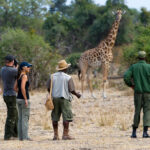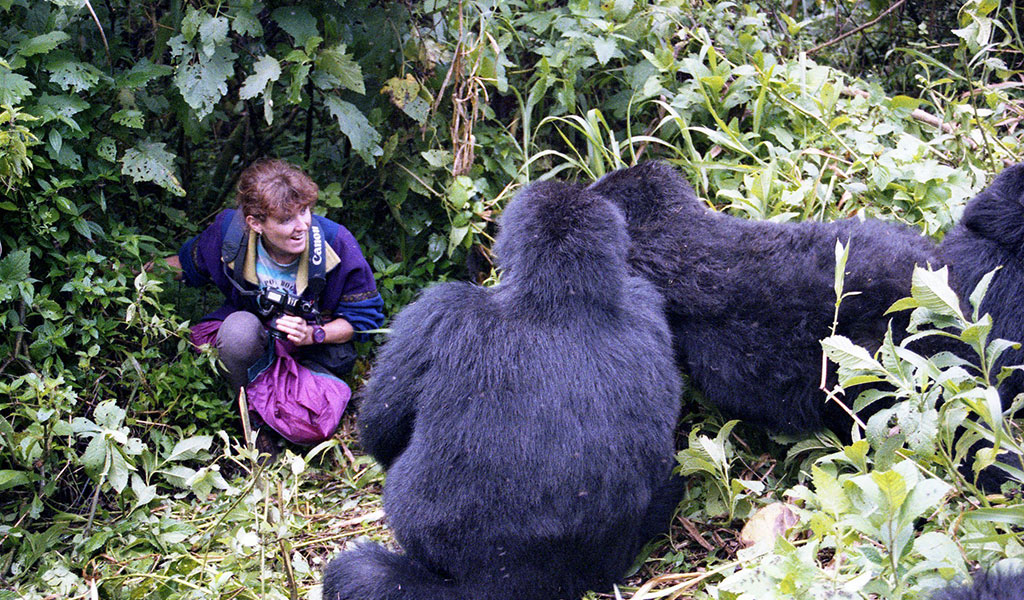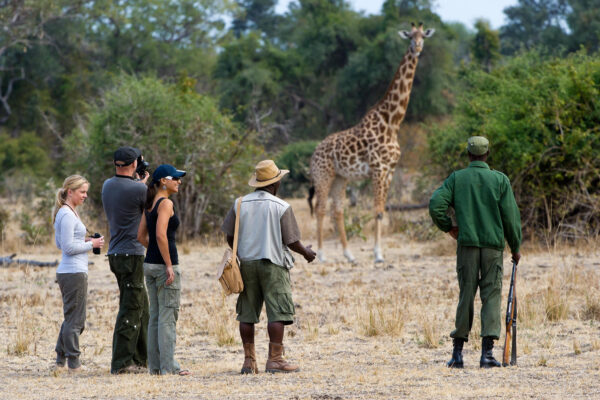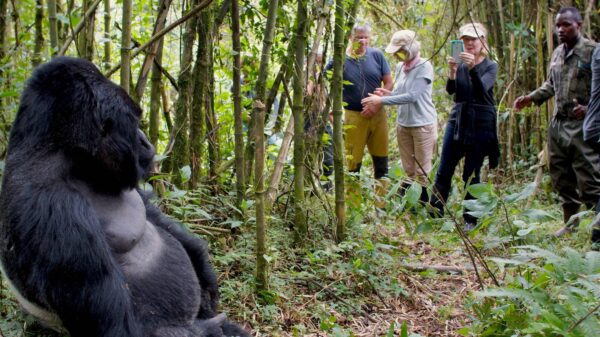
How Close Can I Get to Wildlife on a Walking Safari?
November 27, 2025How Close Can I Get to the Gorillas During a Gorilla Trekking Experience?
How close can I get to the gorillas during a Gorilla Trekking experience? This is one of the most frequently asked questions by travelers planning a Rwanda Gorilla Safari or a Rwanda Gorilla Trekking Safari. These treks offer an extraordinary opportunity to observe mountain gorillas in their natural habitats while respecting wildlife safety and conservation protocols. Whether you are an avid wildlife enthusiast or a first-time traveler, understanding the rules of proximity, trekking etiquette, and the ecological significance of gorilla encounters is essential.
Introduction: Experiencing the Majesty of Gorillas in the Wild
Embarking on a gorilla trekking adventure is more than a safari; it is a transformative journey that combines breathtaking natural landscapes, rare wildlife encounters, and cultural immersion. Rwanda, with its Volcanoes National Park, and Uganda, with Bwindi Impenetrable Forest and Mgahinga Gorilla National Park, remain the only destinations in Africa where travelers can experience these gentle giants. With guidance from expert tour operators like Renai Safaris, visitors can enjoy a safe and memorable trek, while contributing to the conservation of gorillas and their fragile ecosystems.
Gorilla trekking is not just about spotting wildlife; it is about understanding behavior, conservation efforts, and the delicate balance of forest ecosystems. During this safari experience, travelers also have the chance to combine Uganda Gorilla Trekking with other wildlife safaris, such as Big Five game drives, chimpanzee tracking, or birding adventures. By integrating these activities, you gain a comprehensive African safari experience that blends adventure, education, and cultural appreciation.
Gorilla Proximity Guidelines: How Close Can I Get to the Gorillas?
When asking, “How close can I get to the gorillas during a Gorilla Trekking experience?” it’s important to recognize that safety and conservation are paramount. On Rwanda Gorilla Safaris, visitors are advised to maintain a minimum distance of 7 meters (approximately 23 feet) from the gorillas. This distance is carefully regulated by park authorities to protect both humans and gorillas from disease transmission and to prevent stress or behavioral disruptions in these endangered animals.
Gorillas, sharing over 98% of human DNA, are highly susceptible to human illnesses such as colds, flu, or even minor infections. By adhering to distance guidelines, trekkers reduce the risk of inadvertently passing on pathogens that could have catastrophic consequences for gorilla populations. Park rangers and trained guides ensure visitors understand these rules and enforce them during each trek.
Interestingly, despite these regulations, gorillas are wild and may occasionally approach visitors out of curiosity. In such situations, trekkers are advised to remain calm, avoid direct eye contact, and refrain from any sudden movements. While this may allow a more intimate moment with gorillas, it is vital to follow guide instructions at all times. For those on Rwanda Gorilla Trekking Safaris, these encounters are carefully managed to balance personal experience with species protection.
The Gorilla Trekking Journey: What to Expect
A key aspect of understanding “How close can I get to the gorillas during a Gorilla Trekking experience?” lies in appreciating the full trekking journey. Gorilla treks are typically set in lush montane forests, with winding trails, steep hills, and diverse ecosystems that host a range of wildlife species beyond gorillas. On a Rwanda Gorilla Safari, treks usually last between 1 to 3 hours, depending on the location of the gorilla group and terrain conditions. In Uganda’s Bwindi Impenetrable Forest, treks can extend up to 5 hours, challenging even experienced hikers, but rewarding with unparalleled wildlife encounters.
Once you locate a gorilla family, visitors are permitted one hour to observe and photograph these incredible animals. During this time, you can witness their intricate social behaviors, interactions among infants, and communication signals that reflect intelligence and emotional depth. Flash photography is prohibited to avoid startling the gorillas, and guides provide education on gorilla habits, vocalizations, and family hierarchies, enhancing your understanding of their ecology.
For wildlife enthusiasts, Rwanda Wildlife Safaris offer opportunities to combine gorilla trekking with sightings of golden monkeys, forest duikers, and endemic bird species, making the journey even more enriching. Rwanda Birding Safaris are particularly notable for bird lovers, as the forest is home to species like the grey-capped warbler, mountain yellow warbler, and the iconic Rwenzori turaco. These complementary experiences enrich the safari beyond gorilla encounters.
Combining Gorilla Trekking with Other Safari Experiences
When considering “How close can I get to the gorillas during a Gorilla Trekking experience?” many travelers also ask how to maximize their time in East Africa. Renai Safaris emphasizes the value of combining gorilla trekking in Rwanda or Uganda with other safari activities. For example, after a morning with gorillas, visitors can explore Rwanda Chimpanzee Safaris in Nyungwe Forest National Park, witnessing chimpanzees in dynamic social interactions.
Similarly, a Rwanda Best Safaris itinerary might include a scenic drive through Akagera National Park for Big Five sightings or a guided birding tour through the Nyungwe canopy walk. In Uganda, combining gorilla trekking with Murchison Falls Safaris or chimpanzee tracking in Kibale Forest allows for a multi-faceted safari experience. This combination not only maximizes wildlife sightings but provides educational insights into species conservation and ecological balance.
By blending these experiences, travelers enjoy a seamless narrative of East Africa’s biodiversity—from the misty forests of Volcanoes National Park to the savannahs dotted with elephants, lions, and buffaloes. Each safari moment enhances understanding of Africa’s wildlife, ecology, and the critical conservation work underpinning these experiences.
Cultural Immersion: Beyond Wildlife Encounters
Gorilla trekking is inherently linked to the human communities surrounding the forests. On a Rwanda Cultural Safari, visitors can engage with local communities to experience traditional music, dance, and crafts. In Rwanda, villagers often host visitors for coffee ceremonies, storytelling sessions, or demonstrations of basket weaving, providing a meaningful cultural connection that complements the wildlife adventure.
In Uganda, encounters with the Batwa communities around Bwindi Impenetrable Forest provide insights into ancient forest lifestyles and indigenous knowledge. These experiences not only educate visitors but also support local economies and conservation initiatives. Asking, “How close can I get to the gorillas during a Gorilla Trekking experience?” opens the door to broader questions about ethical tourism: how your presence can positively impact both wildlife and communities.
Combining Rwanda Gorilla Trekking Safaris with cultural excursions creates a richer narrative. Visitors leave with memories of both wildlife encounters and human stories, gaining a comprehensive understanding of the region’s heritage, traditions, and conservation efforts. Cultural immersion enhances your safari experience by adding depth, context, and a personal connection to the places and people you encounter.
Practical Tips for a Safe and Rewarding Gorilla Trekking Safari
To answer “How close can I get to the gorillas during a Gorilla Trekking experience?” safely, preparation is key. Trekking permits are limited and highly sought after, making early booking essential. Peak trekking months—June to September and December to February—offer favorable weather for forest trails, ensuring safer and more enjoyable hikes.
Physical preparation is also recommended. Though the gorilla encounter itself is a highlight, trekking through dense forests with uneven terrain can be physically demanding. Comfortable hiking boots, long sleeves, rain gear, and insect repellent are essential items. Guides from Renai Safaris provide briefings on behavior, photography etiquette, and emergency procedures, ensuring that each visitor adheres to park regulations while enjoying a seamless experience.
For photographers and wildlife enthusiasts, understanding gorilla behavior is critical. Remain patient, quiet, and respectful, and use cameras without flash. This approach not only safeguards the gorillas’ well-being but also ensures that visitors witness authentic interactions rather than stressed or disturbed behaviors. By respecting wildlife boundaries, trekkers contribute to sustainable tourism, ensuring that these majestic creatures continue to thrive for generations.
Conservation and Ethical Tourism: Why Distance Matters
“How close can I get to the gorillas during a Gorilla Trekking experience?” is fundamentally a question of ethical tourism and conservation. Mountain gorillas remain endangered, with populations threatened by habitat loss, poaching, and disease. Observing them responsibly, at safe distances, plays a crucial role in their survival.
Rwanda Gorilla Safaris and Rwanda Gorilla Trekking Safaris actively support conservation efforts by funding anti-poaching patrols, veterinary programs, and community development projects. By adhering to recommended distances, visitors minimize stress and disturbance to gorillas, allowing them to live and breed naturally. Ethical tourism practices also demonstrate respect for local communities, who are vital partners in conservation initiatives.
The impact of your safari extends beyond personal experience. Each trek contributes to research, conservation, and the economic empowerment of communities around national parks. By asking how close you can get and respecting the answer, you participate in preserving Rwanda and Uganda’s remarkable biodiversity while enjoying an unforgettable journey.
Final Thoughts: A Transformative Wildlife Experience
“How close can I get to the gorillas during a Gorilla Trekking experience?” is more than a practical inquiry—it is an invitation to connect deeply with nature, wildlife, and local communities. Renai Safaris ensures that each trek, whether part of Rwanda Best Safaris or combined with Uganda Gorilla Trekking, delivers safety, authenticity, and transformative experiences.
Gorilla trekking is a journey of awe, respect, and learning. Maintaining the appropriate distance allows visitors to witness intimate social interactions, family dynamics, and the gentle intelligence of mountain gorillas. When combined with wildlife safaris, birding adventures, or cultural interactions, the experience becomes multidimensional, offering a holistic understanding of East Africa’s natural and cultural richness.
Every encounter, every trek, and every photograph taken responsibly is a contribution to conservation, sustainable tourism, and the preservation of one of the planet’s most remarkable species. By planning with expertise, choosing ethical operators, and respecting park guidelines, travelers ensure that their gorilla trekking adventure remains safe, memorable, and impactful.
In conclusion, the question “How close can I get to the gorillas during a Gorilla Trekking experience?” opens the door to a larger journey—one that encompasses wildlife, culture, education, and conservation. With careful planning, respect for wildlife, and the guidance of professionals like Renai Safaris, you can enjoy a safe, intimate, and unforgettable adventure in the heart of Africa.





